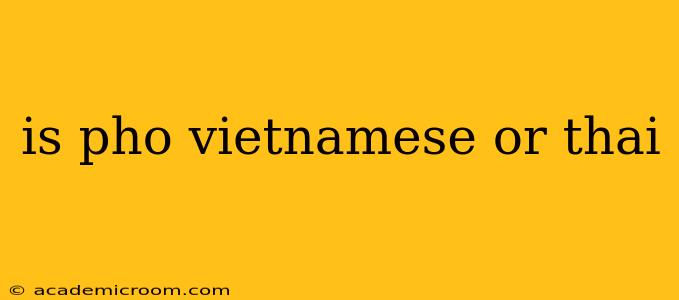The question, "Is pho Vietnamese or Thai?" is easily answered: Pho is definitively a Vietnamese dish. While Thailand boasts a rich culinary heritage with its own delicious noodle soups, pho's origins and cultural significance firmly place it within Vietnamese cuisine. This article will delve deeper into the history and cultural context of pho, dispelling any confusion and highlighting its unique characteristics.
What is Pho?
Pho (phở) is a fragrant and flavorful Vietnamese noodle soup. It's a national dish, deeply ingrained in Vietnamese culture and daily life. Its rich broth, typically simmered for hours with aromatic spices, herbs, and often beef bones, forms the heart of this beloved dish. Served with rice noodles, thinly sliced meat (beef is most common, but chicken and seafood variations exist), fresh herbs like basil and cilantro, and bean sprouts, pho offers a delightful balance of flavors and textures.
The History and Origins of Pho: Why it's Vietnamese
The exact origins of pho are debated, but most historical accounts point to its emergence in northern Vietnam during the late 19th and early 20th centuries. Some theories suggest influences from French colonial cuisine, particularly the French beef broth traditions, but the final product is uniquely Vietnamese. The use of specific spices and herbs, the preparation techniques, and its overall cultural significance within Vietnam all point to its distinct Vietnamese identity.
What are the Key Differences Between Pho and Thai Noodle Soups?
While both Vietnamese pho and Thai noodle soups feature noodles in broth, several key distinctions set them apart:
-
Broth: Pho broth is typically characterized by its rich, clear, and often subtly sweet flavor profile achieved through long simmering with spices like star anise, cloves, cinnamon, and ginger. Thai noodle soup broths often feature a more pronounced, sometimes spicy, and often tangy flavor profile, using ingredients like lemongrass, galangal, and fish sauce.
-
Noodles: Pho uses flat rice noodles. Thai noodle soups utilize a wider variety of noodles, including rice vermicelli, egg noodles, and others.
-
Meat: While beef is the most common protein in pho, chicken and seafood variations exist. Thai noodle soups have a broader range of protein options, including pork, chicken, seafood, and tofu.
-
Herbs and Garnishes: Pho is typically garnished with fresh herbs like basil, cilantro, and bean sprouts, along with lime wedges and chili slices. Thai noodle soups employ a different array of herbs and garnishes, often including things like Thai basil, mint, and chopped peanuts.
How Did the Confusion Arise?
The confusion regarding pho's origin might stem from the increasing global popularity of both Vietnamese and Thai cuisines. Both feature noodle soups as prominent dishes, leading to some overlap in perception for those unfamiliar with the nuances of each culinary tradition. However, understanding the historical context and key differences quickly clarifies pho's unambiguous Vietnamese roots.
Is there a Thai equivalent to Pho?
While there isn't a direct Thai equivalent to pho, Thailand offers a wide range of delicious and flavorful noodle soups with their unique characteristics. These soups showcase the distinct culinary traditions of Thailand, different from the Vietnamese approach to pho.
Conclusion: Pho's Vietnamese Identity
In conclusion, pho is unequivocally a Vietnamese dish. Its history, preparation, ingredients, and cultural significance are firmly rooted in Vietnamese culinary tradition. While similar noodle soups exist in other Southeast Asian countries, pho's unique characteristics and profound cultural impact within Vietnam solidify its Vietnamese identity.
